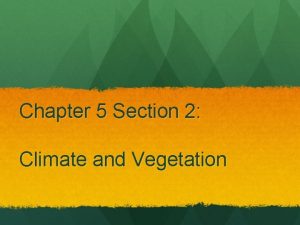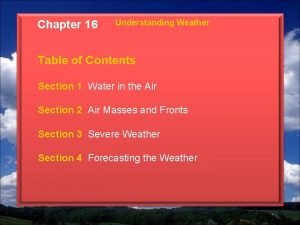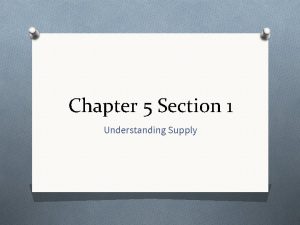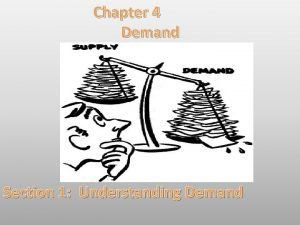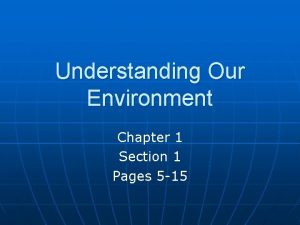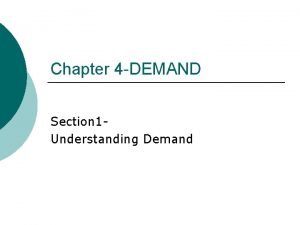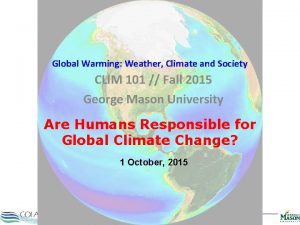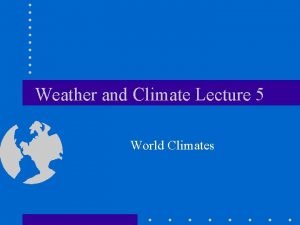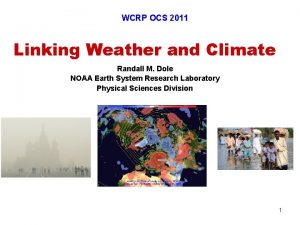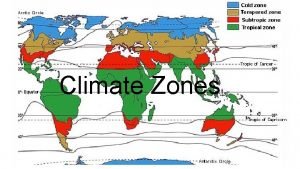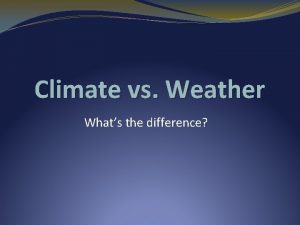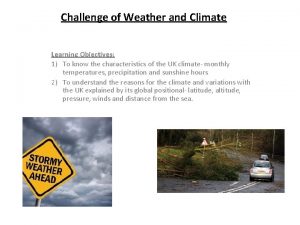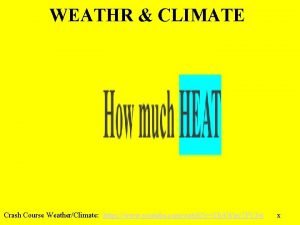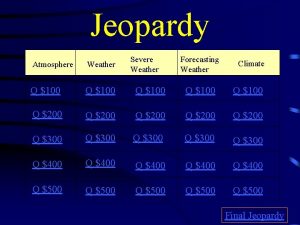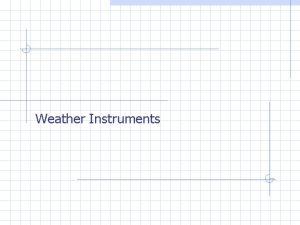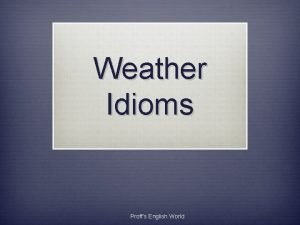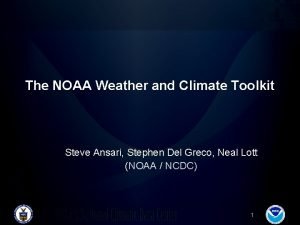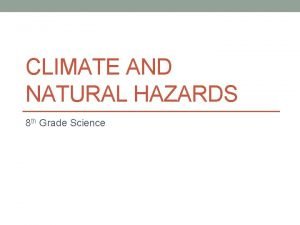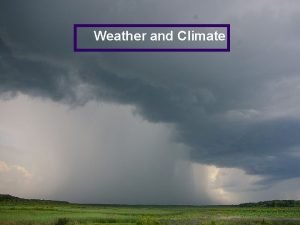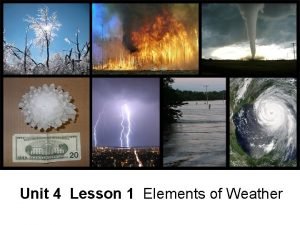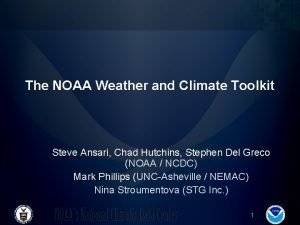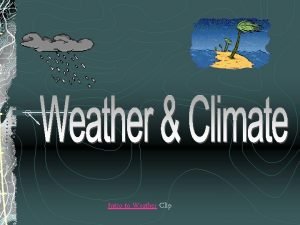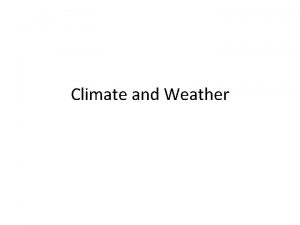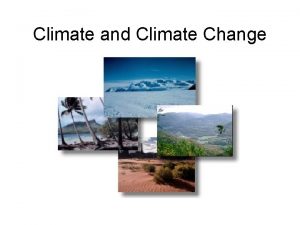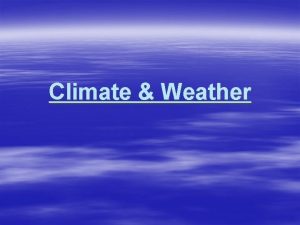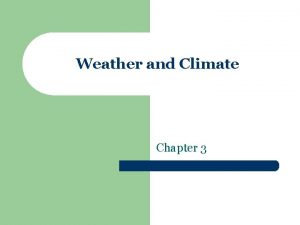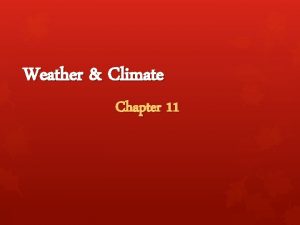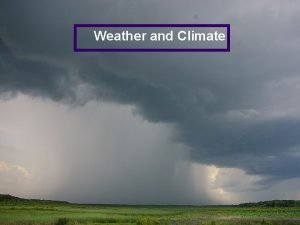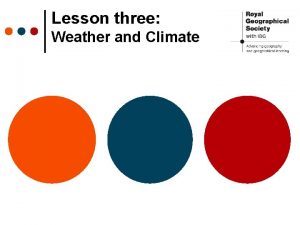WEATHER AND CLIMATE Chapter 2 UNDERSTANDING WEATHER Section































- Slides: 31

WEATHER AND CLIMATE Chapter 2 UNDERSTANDING WEATHER

Section 1 A Water in the Air

the condition of the atmosphere at a particular time and place weather

the continuous movement of water from water sources into the air, onto land, into and over ground, and back to the water sources water cycle

the change of state from a liquid to a vapor evaporation

the process by which plants release water vapor into the air through their leaves transpiration

the change of state from a gas to a liquid condensation

solid or liquid water that falls from the air to the Earth precipitation

Cold Weather Precipitation

water, usually from precipitation, that flows across land collects in rivers, streams, and eventually the ocean runoff

the amount of water vapor or moisture in the air humidity

As water evaporates, the humidity of the air _____. increases

Humidity can cause a _____ day. bad hair

As temperature decreases, the air’s ability to hold moisture _____. decreases

Warmer air can hold _______ more water vapor than cooler air.

the amount of moisture the air contains compared with the maximum amount it can hold at a particular temperature relative humidity Actual Amount Compared to Maximum Amount Relative Humidity of 5/10 =50%

Calculate Relative Humidity: • The air actually holds 8 grams of water vapor at a temperature that could hold 32 grams of water vapor 25% • The air could hold 50 grams of water vapor but actually holds 40 80% Hint: Divide the amount in the air by the amount it can hold. Then multiply by 100.

instrument used to measure wind speed anemometer

an instrument used to measure relative humidity psychrometer

Using the following slide, determine the relative humidity when: • the dry-bulb reading is 16˚C with a wet-bulb difference of 7

Relative Humidity (in Percentage) Difference Between Wet-Bulb Reading and Dry-Bulb Reading ˚C 1 2 3 4 5 6 7 8 0 81 64 46 29 13 2 84 68 52 37 22 7 4 85 71 57 43 29 16 6 86 73 60 48 35 24 11 8 87 75 63 51 40 29 19 8 10 88 77 66 55 44 34 24 15 12 89 78 68 58 48 39 29 21 14 90 79 70 60 51 42 34 26 16 90 81 71 63 54 46 38 30 18 91 82 73 65 57 49 41 34 20 91 83 74 66 59 51 44 37

Using the following slide, determine the relative humidity when: • the dry-bulb reading is 4˚C and the wet-bulb reading is 10˚C. HINT: 1 st Find the difference! 10 – 4 = 6

Relative Humidity (in Percentage) Difference Between Wet-Bulb Reading and Dry-Bulb Reading ˚C 1 2 3 4 5 6 7 8 0 81 64 46 29 13 2 84 68 52 37 22 7 4 85 71 57 43 29 16 6 86 73 60 48 35 24 11 8 87 75 63 51 40 29 19 8 10 88 77 66 55 44 34 24 15 12 89 78 68 58 48 39 29 21 14 90 79 70 60 51 42 34 26 16 90 81 71 63 54 46 38 30 18 91 82 73 65 57 49 41 34 20 91 83 74 66 59 51 44 37

When air holds all the water it can hold at a given temperature, it is said to be _____. saturated

Saturated air has a relative humidity of ____%. 100

If the amount of water vapor in the air stays the same, the relative humidity _____ decreases as the temperature rises.

Before condensation can occur, the air must be saturated and cooled. ____

the temperature to which air must cool to be completely saturated dew point

Before it can condense, water vapor must have a _______ surface on which it can condense.

Fun and Games • Bill Nye the Science Guy on “The Water Cycle” • Part 1 • Part 2 • Part 3 • Magic School Bus “Wet All Over” • Water Cycle Animation

Fun and Games • Brain POP Video, Activities, and Quiz on Humidity User Name: tabernaclesd_2 Password: brainpop • Water Cycle • Vocabulary Games
 World geography today
World geography today Chapter 5 section 2 climate and vegetation answer key
Chapter 5 section 2 climate and vegetation answer key Chapter 21 section 2 climate and vegetation
Chapter 21 section 2 climate and vegetation Chapter 13 atmosphere and climate change section 1
Chapter 13 atmosphere and climate change section 1 Climate change 2014 mitigation of climate change
Climate change 2014 mitigation of climate change Chapter 16 understanding weather answer key
Chapter 16 understanding weather answer key Chapter 5 section 1 understanding supply
Chapter 5 section 1 understanding supply Lesson 1: understanding demand
Lesson 1: understanding demand Chapter 1 section 1 understanding our environment answers
Chapter 1 section 1 understanding our environment answers Economics chapter 4 section 1 understanding demand answers
Economics chapter 4 section 1 understanding demand answers Weather climate and society
Weather climate and society What is this
What is this Cimates
Cimates Conclusion of weather and climate
Conclusion of weather and climate 12 climate zones map
12 climate zones map Whats the difference between weather and climate
Whats the difference between weather and climate Objectives of weather and climate
Objectives of weather and climate Weathr
Weathr Youtube.com
Youtube.com What single factor controls humidity
What single factor controls humidity Weather and climate jeopardy
Weather and climate jeopardy Weather and climate interactive activities
Weather and climate interactive activities Tools used to measure weather
Tools used to measure weather Rains proff
Rains proff Short poem about seasons
Short poem about seasons Weather and climate toolkit
Weather and climate toolkit Explain how some hail can become baseball sized
Explain how some hail can become baseball sized Weatherlll
Weatherlll Kahoot.com
Kahoot.com What are the elements of weather
What are the elements of weather Weather and climate toolkit
Weather and climate toolkit Brainpop weather
Brainpop weather

